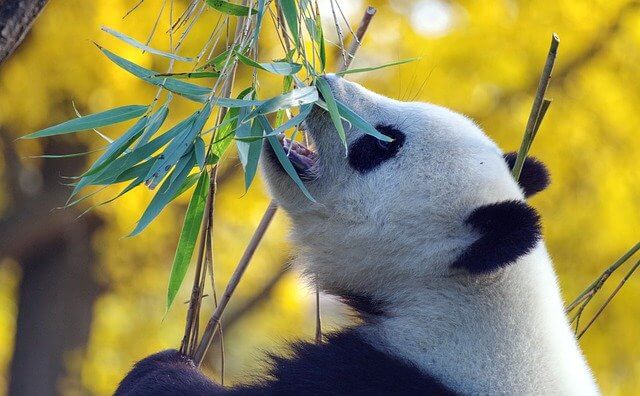What are the types of Panda? Information on panda animal, living habitat, reproduction and features.

Panda; a name applicable to either of the two species of Asiatic mammals that make up the subfamily Ailurinae. The pandas are the only representatives of the raccoon family (Procyonidae) that are native to the Old World. Although closely allied anatomically, the two pandas are strangely unlike, one being large, short tailed, and bearlike, while the other is small, long tailed and catlike. Both pandas live at high elevations in eastern Asia, have semiretractile claws, walk on the soles of their feet, and have broad-crowned molar teeth. Although primarily vegetarians, the pandas are related to the carnivores.
Lesser Panda or Cat Bear (Ailurus):
This is an ornate short-legged bushy-tailed animal with a head and body length of about 2 feet. Its long luxuriant body fur varies in color from ruby red to deep chestnut, the face and erect ears are contrastingly white, while the limbs, feet, and underparts may be a deep red or almost black. Its long bushy tail, about 16 inches in length, is ringed with alternate dark and light bands of red or buff.
The lesser panda frequents the forested mountain slopes of Nepal and the provinces of Yunnan and Szechwan in China at elevations of 7,000 to 12,000 feet. It lives in trees and lies up during the day in hollow tree trunks. It is largely vegetarian and feeds on bamboo shoots, leaves, and fruit, but may vary its diet with some small animal life such as insects, mice, birds, and birds’ eggs. The young, limited to a single pair in a litter, open their eyes for the first time when a month old. The lesser panda mates for life, and the young of two litters may remain in the mother’s care for some time. The animal becomes tame when taken young, but dislikes being fondled or caressed.
Giant Panda (Ailuropoda):
This bob-tailed giant of the raccoon family may reach a length of 6 feet and weigh up to 200 pounds. A strikingly marked color pattern makes the animal undetectable against a background of snow, black rocks, and dark shadows. The dense hair covering the large head and body is creamy white except for a broad black band over the shoulders that extends down the massive forelimbs to the feet. The hind limbs and the large erect ears also are black, and there is a black patch around each eye.
Like the bear, the giant panda has a lumbering gait but climbs well and is agile in the trees. In the natural state, it feeds exclusively on shoots, stalks, and leaves of the bamboo. For this diet it has developed excessively large, broad molar teeth, massive jaws, and masseter muscles capable of tremendous crushing power. Native to the dense bamboo forest in northern Szechwan and Kansu in China, it lives at elevations of 6,000 to 14,000 feet. The cubs, one or two in a litter born during the winter season, weigh 60 pounds by the end of the first year.
Although the giant panda was long known to the Chinese as the bei-shung (white bear), its existence was questioned by the Western world until comparatively recent years. Traveling in Asia in 1869, the French missionary Armand David reported the occurrence of a large animal which he took to be a parti-colored bear. Tames Huston Edgar, a missionary of Scottish descent stationed in China, however, was perhaps the first European to see the giant panda in the wild.
The first living giant panda was taken to the United States in 1937. In 1972, following President Richard M. Nixon’s visit to the People’s Republic of China, the Chinese presented a pair of giant pandas to the American people. These pandas, housed in the National Zoo in Washington, D.C., were the first in the United States in about 20 years. The only other captive panda outside China was in the Moscow zoo.